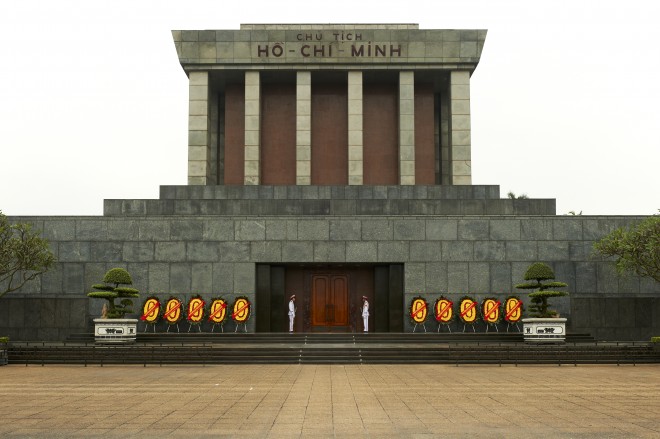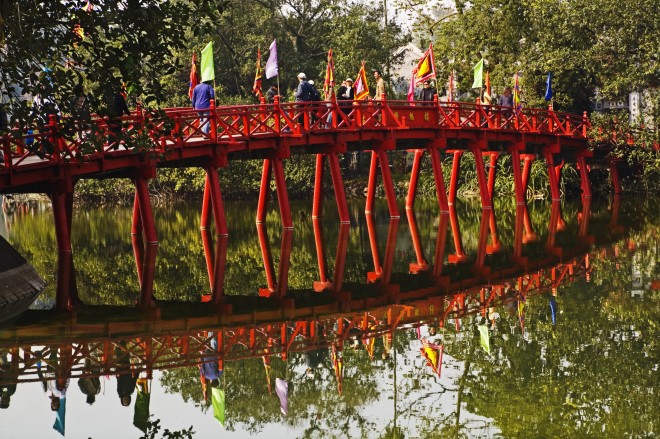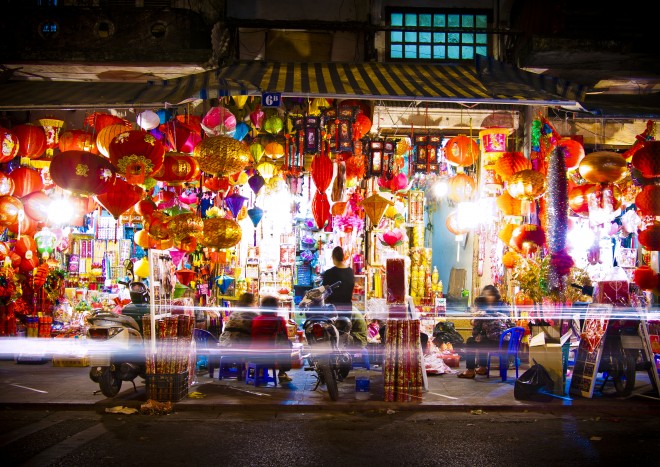
The best way to explore Vietnam’s beguiling capital is to get a local to give you the inside track, says Alex Whittleton.
I arrived at my hotel in Hanoi’s brash and beautiful old town in a state of bleary-eyed excitement. My flight had been long and sleepless, but I’d just had one of the most entertaining taxi rides of my life. The 45-minute trip across town from the airport felt like a kaleidoscopic dream – dazzlingly colourful, deafeningly loud, and the perfect primer for a stay in the animated capital of Vietnam.
The first thing that struck me from the taxi was the implausible number of motorbikes swarming down the road: a family of five was perched perilously on one, a filing cabinet was strapped to the back of another, and a girl carrying a (rapidly expiring) foot-long fish rode on a third. I soon realised that this was nothing out of the ordinary. A tide of motorised humanity washes down the streets of Hanoi day and night, against a backdrop of flashing neon signs, vast billboards and charming French-colonial architecture. The journey was a vivid initiation to Hanoi – I could barely hear myself think with the incessant buzz of engines, beeping of horns and clatter of street vendors. And if I was experiencing sensual overload inside the taxi, I wondered what on earth it would be like on the outside.
After dumping my bags at the hotel, I had just enough time for a quick shower before the main event of my day – a walking tour of the city with a local student. I’d booked through HanoiKids, a student-run outfit that pairs up local youngsters who want to practice their English with visitors who want the inside track. You can have a half- or full-day tour, and it’s completely free. I couldn’t imagine a better way to see the city.
At 9am prompt, I was picked up from my hotel by Na, a friendly 20-year-old from Hanoi University. I must’ve looked like a typically frazzled tourist in need of perking up, because she took me straight to a street kitchen for a breakfast of pho. Ordinarily, I’d have found beef and noodle soup too much first thing in the morning, but I was saved by a confused body clock that thought it was supper time. Sitting on the street in the early-morning sunshine, planning an itinerary with Na, I felt a keen sense of anticipation – our first stop was to be the city’s famously tumultuous ancient quarter.
Made up of 36 higgledy-piggledy lanes, each named after a particular craft, Hanoi’s ancient quarter is jam-packed with people flogging their wares: everything from bamboo baskets to paper lanterns spill out onto the pavements, which double up as workshops. My abiding memory of this extraordinary square mile, however, will be the delicious scents that filled the air. Fresh vegetables, sizzling meat, piping hot green tea, and sweet doughnuts were being hungrily dispatched at makeshift kitchens on every street corner, and I couldn’t help but feel ravenous, despite my enormous breakfast.
We meandered south, swapping the commotion of the ancient quarter for the relative calm of Hoan Kiem Lake – the focal point of the modern city, where people go to exercise, play chess or simply take a breather. Na led the way down thoroughfares and backstreets, past chic boutiques, crumbling façades and ancient temples.
I found crossing the road a heart-pounding, dizzying ordeal. Lane discipline in Hanoi is non-existent, and zebra crossings and traffic lights are resolutely ignored. To get from one side of the street to the other, you simply step out and hope for the best. I was lucky I had Na to grip onto.
After a lakeside lunch of spring rolls and a chat about Na’s teacher-training studies, we made our way to the formidable Hoa Lo Prison, dubbed the “Hanoi Hilton” by American prisoners of war in the 1960s. It’s a captivating, haunting place that documents the miserable lives of its inmates with preserved solitary-confinement cells and horrifying displays of torture instruments. A mere 30 minutes inside was enough, and I felt relieved to see the street again.
The rest of the afternoon passed in a happy haze of chatter and sightseeing. Between motorbike-dodging and doughnut-eating, Na told me about the importance of ancestral worship for Vietnamese families. This emphasis on filial devotion comes from Confucius, whose teachings have shaped the society. It felt like the right moment to see the great philosopher’s shrine at the nearby Temple of Literature before visiting our final sight, the Ho Chi Minh Mausoleum – another shrine, but to a much more modern hero. The final resting place for the embalmed body of Vietnam’s charismatic Communist leader has become a pilgrimage site for people from across the country.
The light was fading fast, so we jumped in a taxi back to the hotel. Looking out, the streets now felt like an old and familiar friend. This tour had been every bit as thrilling as I’d imagined. And thanks to Na, I’d explored hidden side-streets, heard stories of family and cultural life, and, perhaps most importantly, figured out how to cross the road.
By Alex Whittleton
April 29th, 2013
www.roughguides.com



